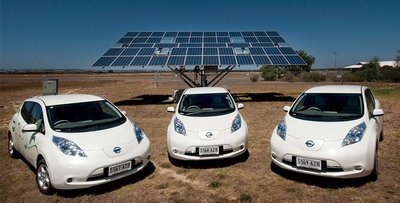Kangaroo Island Visible Solar Project bounds into action
The $500,000 Kangaroo Island Visible Solar Project has been officially opened. The project was launched this week by Geoff Knight, CEO of the Department for Manufacturing, Innovation, Trade, Resources and Energy; Mayor Jayne Bates, Kangaroo Island; and Mayor Ann Ferguson, chairperson of Regional Development Australia (Adelaide Hills, Fleurieu and Kangaroo Island).
Funded by the state government’s RenewablesSA program, the project boasts the first dual-axis solar trackers in Australia to power electric vehicles. The solar array system is installed at the Kangaroo Island Airport and tracks the sun. It is said to increase the energy output by 30% compared to a fixed system and to generate 100 MWh a year - enough to power 13 homes.
Solar power provider Ingenero delivered a solar PV system and electric vehicle charge network to maximise benefits to the Kangaroo Island community. The company’s national sales manager, Patrick Greene, said, “Ingenero worked collaboratively with council to deliver a solution that not only powers the entire airport but reduces fuel costs and emissions, whilst also providing the island with another eco-tourism attraction.
“We recommended the dual-axis trackers to the council because we had seen from previous projects the trackers perform better than static panels. By following the path of the sun throughout the day, the panels are exposed to sunlight for a longer period of time, maximising power production.”

The council was further able to install a 14 kW rooftop solar system at the Kingscote Town Hall to offset its power bill there; install infrastructure to recharge electric cars (at the airport, Kingscote, Penneshaw, Parndana and American River); and lease three Nissan LEAF electric vehicles, two of which can be hired by the public. The excess power produced at the airport, in addition to the rooftop solar system, will support the charging of the Nissan vehicles.
Mayor Bates said the project will deliver financial benefits to the community as well as environmental ones, stating, “It’s a terrific project and part of this island’s quest to generate more of its own electricity, which has been one of the key barriers to encouraging growth and development here.
“The solar trackers at the airport have already shown an 80% reduction in energy costs (inclusive of use of green energy and exporting surplus power to the grid), equating to around $24,000 per annum in savings at the airport alone.”
The project is already gaining interest from national and international parties. Within the first few months of commissioning the infrastructure, the project became a catalyst for interest in potential value-added investment into the renewable energy and business sector on the island.
“We are confident that Kangaroo Island can build on this significant opportunity provided by the SA government,” said Kangaroo Island Council CEO Andrew Boardman. “We are already receiving significant domestic and overseas interest in the potential expansion of green energy infrastructure on Kangaroo Island.”
Partnership brings innovative fuel solutions to Gippsland
A study by European Energy Australia and Opal at the latter's Maryvale Paper Mill will assess...
Data centres — a missed opportunity for sustainability
The question is no longer whether we need data centres, but how we plan, locate and govern...
Sodium-ion battery may provide greener energy
Scientists say sodium-ion batteries may be the answer to the future of sustainable energy storage...







